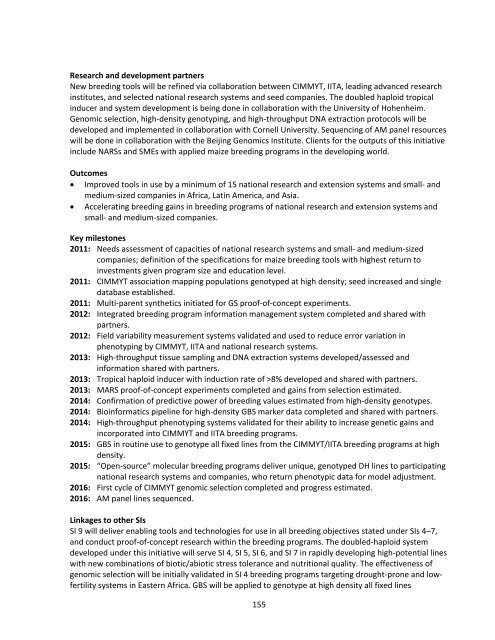Download - Maize
Download - Maize
Download - Maize
Create successful ePaper yourself
Turn your PDF publications into a flip-book with our unique Google optimized e-Paper software.
Research and development partners<br />
New breeding tools will be refined via collaboration between CIMMYT, IITA, leading advanced research<br />
institutes, and selected national research systems and seed companies. The doubled haploid tropical<br />
inducer and system development is being done in collaboration with the University of Hohenheim.<br />
Genomic selection, high‐density genotyping, and high‐throughput DNA extraction protocols will be<br />
developed and implemented in collaboration with Cornell University. Sequencing of AM panel resources<br />
will be done in collaboration with the Beijing Genomics Institute. Clients for the outputs of this initiative<br />
include NARSs and SMEs with applied maize breeding programs in the developing world.<br />
Outcomes<br />
Improved tools in use by a minimum of 15 national research and extension systems and small‐ and<br />
medium‐sized companies in Africa, Latin America, and Asia.<br />
Accelerating breeding gains in breeding programs of national research and extension systems and<br />
small‐ and medium‐sized companies.<br />
Key milestones<br />
2011: Needs assessment of capacities of national research systems and small‐ and medium‐sized<br />
companies; definition of the specifications for maize breeding tools with highest return to<br />
investments given program size and education level.<br />
2011: CIMMYT association mapping populations genotyped at high density; seed increased and single<br />
database established.<br />
2011: Multi‐parent synthetics initiated for GS proof‐of‐concept experiments.<br />
2012: Integrated breeding program information management system completed and shared with<br />
partners.<br />
2012: Field variability measurement systems validated and used to reduce error variation in<br />
phenotyping by CIMMYT, IITA and national research systems.<br />
2013: High‐throughput tissue sampling and DNA extraction systems developed/assessed and<br />
information shared with partners.<br />
2013: Tropical haploid inducer with induction rate of >8% developed and shared with partners.<br />
2013: MARS proof‐of‐concept experiments completed and gains from selection estimated.<br />
2014: Confirmation of predictive power of breeding values estimated from high‐density genotypes.<br />
2014: Bioinformatics pipeline for high‐density GBS marker data completed and shared with partners.<br />
2014: High‐throughput phenotyping systems validated for their ability to increase genetic gains and<br />
incorporated into CIMMYT and IITA breeding programs.<br />
2015: GBS in routine use to genotype all fixed lines from the CIMMYT/IITA breeding programs at high<br />
density.<br />
2015: “Open‐source” molecular breeding programs deliver unique, genotyped DH lines to participating<br />
national research systems and companies, who return phenotypic data for model adjustment.<br />
2016: First cycle of CIMMYT genomic selection completed and progress estimated.<br />
2016: AM panel lines sequenced.<br />
Linkages to other SIs<br />
SI 9 will deliver enabling tools and technologies for use in all breeding objectives stated under SIs 4–7,<br />
and conduct proof‐of‐concept research within the breeding programs. The doubled‐haploid system<br />
developed under this initiative will serve SI 4, SI 5, SI 6, and SI 7 in rapidly developing high‐potential lines<br />
with new combinations of biotic/abiotic stress tolerance and nutritional quality. The effectiveness of<br />
genomic selection will be initially validated in SI 4 breeding programs targeting drought‐prone and lowfertility<br />
systems in Eastern Africa. GBS will be applied to genotype at high density all fixed lines<br />
155

















